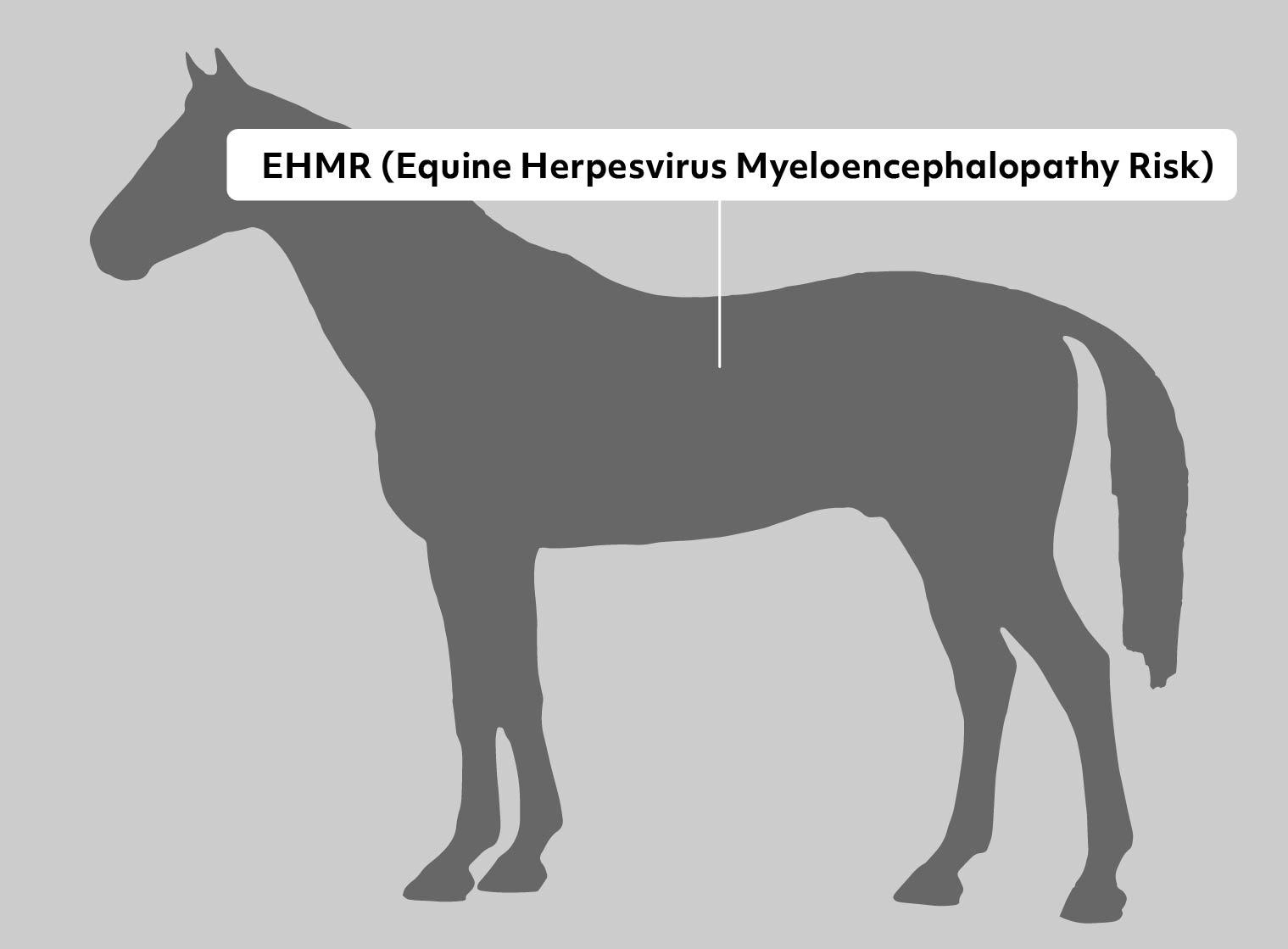Equine Herpes Virus Type 1 & Induced Myeloencephalopathy (EHV-1 / EHM)
Gene or Region: intron of TSPAN9
Reference Variant: G
Mutant Variant: A
Affected Breeds: Diverse breeds from the US, Canada and Europe
Research Confidence: Discovery - Findings require expanded validation
Explanation of Results: EHMR/EHMR = homozygous for EHV-1 Induced Myeloencephalopathy Risk, 1.43x increased risk EHMR/n = heterozygous for EHV-1 Induced Myeloencephalopathy Risk, 1.43x increased risk n/n = no variant detected
Equine Herpesvirus (EHV-1) and Myeloencephalopathy (EHM): Understanding Risks, Symptoms, and Prevention
EHV-1 stands for Equine Herpes Virus type 1. Equine herpesviruses are DNA viruses that are found in horses all over the world, the majority of which will have no serious side effects. EHV-1 can cause four manifestations of disease in horses, including the neurological form, respiratory disease, abortion, and neonatal death.
Equine Herpesvirus Myeloencephalopathy (EHM) is the neurologic disease associated with Equine Herpes Virus type 1 (EHV-1), representing one outcome of infection. This occurs to a subset of infected horses and its symptoms are painful and sometimes fatal. Neurologic signs result from inflammation of the blood vessels, blood clots, and death of neurologic tissue. EHM can affect one or multiple infected horses in a group.
After infection, the incubation period is typically 4-6 days, but may be as short as 24 hours. EHV-1 typically causes a two-phase fever peaking on day 1 or 2 and again on day 6 or 7. Respiratory infections often present nasal and ocular discharge, and minimal coughing. There may also be some persistent enlargement of lymph nodes under the jaw. The neurologic form of EHV-1 (EHM) presents with minimal respiratory signs, and fever (rectal temperature greater than 101.5 degrees F) is considered a warning sign. Sudden neurologic disease progresses rapidly and reaches peak intensity within 24 to 48 hours from onset of initial neurologic signs. Horses may develop EHM even without any preceding fever and/or respiratory signs. Clinical signs of EHM may include:
-In-coordination -Hind limb weakness -Loss of tail tone -Lethargy -Urine dribbling -Head tilt -Leaning against a fence or wall to maintain balance -Inability to rise
EHV-1 is contagious and spread by direct horse-to-horse contact via the respiratory tract through nasal secretions. It is important to know that this virus can also be spread indirectly through contact with physical objects that are contaminated with the virus, including but not limited to: human contaminated hands or clothing, contaminated equipment and tack, contaminated trailers used for transporting horses, contaminated wipe rags or other grooming equipment, or contaminated feed and water buckets. The air around the horse that is shedding the virus can also be contaminated. Although it is known that the virus can be airborne, it is difficult to establish the spread distance under typical horse management and environmental conditions.
A genome-wide association study (GWAS) investigated host genetic variations associated with EHM, resulting in a variant (BIEC2_946397) within an intron of the tetraspanin 9 (TSPAN9) gene, which is expressed in endothelial cells and platelets, correlated with a recessive protective effect against EHM in EHV-1 affected individuals. Understanding the contribution of host genetic variation to the development of EHM can help with strategies for treating individual cases and managing outbreaks.
Learn More about EHM and the genetic test for increased risk on our blog.
References
Brosnahan, M. M., Al Abri, M. A., Brooks, S. A., Antczak, D. F., & Osterrieder, N. (2019). Genome-wide association study of equine herpesvirus type 1-induced myeloencephalopathy identifies a significant single nucleotide polymorphism in a platelet-related gene. The Veterinary Journal, 245, 49-54. https://doi.org/10.1016/j.tvjl.2018.12.013
More Horse Health
Congenital Stationary Night Blindness 2
Congenital Stationary Night Blindness (CSNB) is an inherited disorder in horses characterized by an inability to see in low-light or dark conditions. This condition is present from birth and does not worsen over time. Common indicators include a horse’s reluctance to enter dark environments, difficulties in locating food and water in the dark, and a propensity for nighttime injuries.
Equine Arteritis Virus Resistance
Equine Arteritis Virus Resistance (EAVR) is an infectious disease with a broad range of symptoms, though most horses will not display any overt signs. Infection can result in abortion in pregnant mares, and some stallions persistently shed the virus through their semen.
